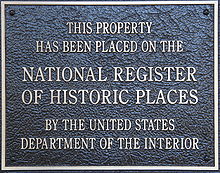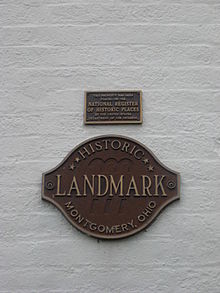National Register of Historic Places
| Agency overview | |
|---|---|
| Formed | 1966 |
| Jurisdiction | United States |
| Headquarters | Main Interior Building, Washington, D.C., U.S. |
| Agency executive |
|
| Parent department | National Park Service |
| Website | nps.gov/nationalregister |
The National Register of Historic Places (NRHP) is the
The enactment of the
For most of its history, the National Register has been administered by the National Park Service (NPS), an agency within the United States Department of the Interior. Its goals are to help property owners and interest groups, such as the National Trust for Historic Preservation, as well as coordinate, identify and protect historic sites in the United States. While National Register listings are mostly symbolic, their recognition of significance provides some financial incentive to owners of listed properties. Protection of the property is not guaranteed. During the nomination process, the property is evaluated in terms of the four criteria for inclusion on the National Register of Historic Places. The application of those criteria has been the subject of criticism by academics of history and preservation, as well as the public and politicians.
Occasionally, historic sites outside of the country, but associated with the United States (such as the American Legation in Tangier) are also listed. Properties can be nominated in a variety of forms, including individual properties, historic districts and multiple property submissions (MPS). The Register categorizes general listings into one of five types of properties: district, site, structure, building or object.
National Register Historic Districts are defined geographical areas consisting of contributing and non-contributing properties. Some properties are added automatically to the National Register when they become administered by the National Park Service. These include
Federal properties can be proclaimed National Monuments under the Antiquities Act because of either their historical or natural significance. They are managed by multiple agencies. Only monuments that are historic in character and managed by the National Park Service are listed administratively in the National Register.
History


On October 15, 1966, the Historic Preservation Act created the National Register of Historic Places and the corresponding
To administer the newly created National Register of Historic Places, the National Park Service of the U.S. Department of the Interior, with director
The first official
In 1979, the NPS history programs affiliated with both the
In February 1983, the two assistant directorates were merged to promote efficiency and recognize the interdependency of their programs. Jerry L. Rogers was selected to direct this newly merged associate directorate. He was described as a skilled administrator, who was sensitive to the need for the NPS to work with SHPOs, academia and local governments.[8]
Although not described in detail in the 1966 act, SHPOs eventually became integral to the process of listing properties on the National Register. The 1980 amendments of the 1966 law further defined the responsibilities of SHPOs concerning the National Register.[9] Several 1992 amendments of the NHPA added a category to the National Register, known as Traditional Cultural Properties: those properties associated with Native American or Hawaiian groups.[5]
The National Register of Historic Places has grown considerably from its legislative origins in 1966. In 1986, citizens and groups nominated 3,623 separate properties, sites and districts for inclusion on the National Register, a total of 75,000 separate properties.[9] Of the more than one and a half million properties on the National Register, 95,000 are listed individually. Others are listed as contributing members within historic districts.[6][10]
Nomination process
It is hereby declared to be the policy of the United States Government that special effort should be made to preserve the natural beauty of the countryside and public park and recreation lands, wildlife and waterfowl refuges, and historic sites.
USC 303)
Any individual can prepare a National Register nomination, although historians and historic preservation consultants often are employed for this work. The nomination consists of a standard registration form (NPS 10-900) and contains basic information about a property's physical appearance and the type of significance embodied in the building, structure, object, site, or district.[12]
The State Historic Preservation Office (SHPO) receives National Register nominations and provides feedback to the nominating individual or group. After preliminary review, the SHPO sends each nomination to the state's historic review commission, which then recommends whether the State Historic Preservation Officer should send the nomination to the Keeper of the National Register. For any non-Federally owned property, only the State Historic Preservation Officer may officially nominate a property for inclusion in the National Register. After the nomination is recommended for listing in the National Register by the SHPO, the nomination is sent to the National Park Service, which approves or denies the nomination.
If approved, the property is entered officially by the Keeper of the National Register into the National Register of Historic Places.[12] Property owners are notified of the nomination during the review by the SHPO and state's historic review commission. If an owner objects to a nomination of private property, or in the case of a historic district, a majority of owners, then the property cannot be listed in the National Register of Historic Places.[12]
Criteria

For a property to be eligible for the National Register of Historic Places, it must meet at least one of its four main criteria.[13] Information about architectural styles, association with various aspects of social history and commerce and ownership are all integral parts of the nomination. Each nomination contains a narrative section that provides a detailed physical description of the property and justifies why it is significant historically with regard either to local, state, or national history. The four National Register of Historic Places criteria are the following:
- Criterion A, "Event", the property must make a contribution to the major pattern of American history.
- Criterion B, "Person", is associated with significant people of the American past.
- Criterion C, "Design/Construction", concerns the distinctive characteristics of the building by its architecture and construction, including having great artistic value or being the work of a master.
- Criterion D, "Information potential", is satisfied if the property has yielded or may be likely to yield information important to prehistory or history.[12]
The criteria are applied differently for different types of properties; for instance, maritime properties have application guidelines different from those of buildings.[13]
Exclusions
The National Park Service names seven categories of properties that "are not usually considered for" and "ordinarily ... shall not be considered eligible for" the National Register: religious properties (e.g., churches); buildings that have been moved; birthplaces or graves of important persons; cemeteries; reconstructed properties; commemorative properties (e.g., statues); and "properties that have achieved significance within the last fifty years".[13]: 25 However, if they meet particular "Criteria Considerations" for their category in addition to the overall criteria, they are, in fact, eligible.[13]: 25 Hence, despite the forbidding language, these kinds of places are not actually excluded as a rule.[14] For example, the Register lists thousands of churches.[15][16] (See also § Misconceptions.)
The National Register evaluation procedures do not use the term "exclusions". The stricter National Historic Landmarks Criteria, upon which the National Register criteria are based,[14] do specify exclusions, along with corresponding "exceptions to the exclusions", which are supposed to apply more narrowly.[13]: 52
Properties listed


A listing on the National Register of Historic Places is governmental acknowledgment of a historic district, site, building, or property. However, the Register is mostly "an honorary status with some federal financial incentives".
Landmarks such as these include
Listing in the National Register does not restrict private property owners from the use of their property.[19]
Some states and municipalities, however, may have laws that become effective when a property is listed in the National Register. If federal money or a federal permitting process is involved, Section 106 of the
While Section 106 does not mandate explicitly that any federal agency director accept the advice of the ACHP, their advice has a practical influence, especially given the statutory obligations of the NHPA that require federal agencies to "take into account the effect of the undertaking".[20][21]
In cases where the ACHP determines federal action will have an "adverse effect" on historic properties, mitigation is sought. Typically, a
The Department of Transportation Act, passed on October 15, 1966, the same day as the National Historic Preservation Act, included provisions that addressed historic preservation. The DOT Act is much more general than Section 106 NHPA in that it refers to properties other than those listed in the Register.[21]
The more general language has allowed more properties and parklands to enjoy status as
-
Pecos Pueblo in Pecos, New Mexico, one of a number of NRHP sites administered by the National Park Service
-
The Illinois State Capitol in Springfield, Illinois, one of 44 U.S. state capitols listed on the NRHP
-
Robert C. Weaver Federal Building in Washington, D.C., an example of a modern building listed on the NRHP
-
American Legation in Tangier, Morocco, the only site on the NRHP in a foreign nation.
-
Walden Pond in Concord, Massachusetts, an example of a natural site listed on the NRHP
-
The USS Wisconsin (BB-64), docked in Norfolk, Virginia, one of a number of ships listed on the NRHP
-
Nan Madol, the ruined ancient city of Pohnpei in the Federated States of Micronesia, named to the NRHP in 1974
-
Louisiana Superdome, now Caesars Superdome, known for its timeless exterior design since first opening in 1975[23]
Multiple property submission

A multiple property submission (MPS) is a thematic group listing of the National Register of Historic Places that consists of related properties that share a common theme and can be submitted as a group. Multiple property submissions must satisfy certain basic criteria for the group of properties to be included in the National Register.
The process begins with the multiple property documentation form which acts as a cover document rather than the nomination to the National Register of Historic Places. The purpose of the documentation form is to establish the basis of eligibility for related properties. The information of the multiple property documentation form can be used to nominate and register related historic properties simultaneously, or to establish criteria for properties that may be nominated in the future. Thus, additions to an MPS can occur over time.
The nomination of individual properties in an MPS is accomplished in the same manner as other nominations. The name of the "thematic group" denotes the historical theme of the properties. It is considered the "multiple property listing". Once an individual property or a group of properties is nominated and listed in the National Register, the multiple property documentation form, combined with the individual National Register of Historic Places nomination forms, constitute a multiple property submission.[24]
Examples of MPS include the









![Louisiana Superdome, now Caesars Superdome, known for its timeless exterior design since first opening in 1975[23]](http://upload.wikimedia.org/wikipedia/commons/thumb/a/ab/Louisiana_Superdome_-_Unbranded_-_26_July_2021.jpg/120px-Louisiana_Superdome_-_Unbranded_-_26_July_2021.jpg)

